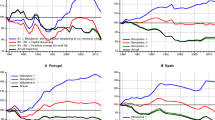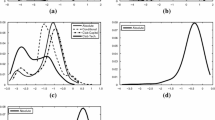Abstract
A sustainable long-run pattern in the relative competitiveness of Euro area countries is a key factor for the survival of the monetary union. We analyse the issue focussing on unit labour cost dynamics using cointegration analysis for the whole economy and for the manufacturing sector separately. Our findings show that the introduction of the Euro has increased, rather than decreased, the distance among member countries, as measured in the metric of unit labour costs. Dispersion of productivity rather than wage compensation suggests that persisting idiosyncratic dynamics are driven by real factors, i.e. diverging technological patterns rather than by monetary factors, expressed by wage compensation.






Similar content being viewed by others
Notes
Ameco database. Compensation of employees (code UWCD); gross domestic product at constant prices (code OVGD); sectoral compensation of employees (code UWCM); sectoral value added at constant prices (code OVGM).
Ameco database.
Rearranging (2) the growth rate of ULC reads:
$$\dot{ULC}= \dot{W^{d}} - \dot{Q}$$(3)Figures for productivity and wage compensation where available separately only from 1990 onwards.
They analyse the following countries: Austria, Belgium, Finland, France, Germany, Ireland, Italy, Spain.
Results of these tests are available from the authors upon request.
Results unreported, available on request.
See Juselius (2006) for a detailed description.
Data available upon request to the authors.
The procedure to obtain the bootstrapped interval has been obtained adapting the procedures written by Vinod and da Lacalle (2009) and using the R package ‘meboot’.
References
Arthur WB (1989) Competing technologies, increasing returns, and lock-in by historical events. Econ J 99(394):116–31
Baumol WJ (1986) Productivity growth, convergence, and welfare: What the long-run data show. Am Econ Rev 76(5):1072–1085
Belke A, Dreger C (2013) Current account imbalances in the euro area. Does catching up explain the development? Rev Int Econ 21(1):6–17
Bertola G (2008) Labour markets in EMU—What has changed and what needs to change. Tech rep, CEPR Discussion Papers
Breitung J (2005) A parametric approach to the estimation of cointegration vectors in panel data. Econ Rev 24(2):151–173
Breusch TS, Pagan AR (1980) The Lagrange multiplier test and its applications to model specification in econometrics. Rev Econ Stud 47(1):239–53
Dosi G (1988) Sources, procedures, and microeconomic effects of innovation. J Econ Lit 26(3):1120–1171
Dullien S, Fritsche U (2008) Does the dispersion of unit labor cost dynamics in the EMU imply long-run divergence? IEEP 5(3):269–295
ECB (2005) Inflation differentials in the euro area: Potential causes and policy implications. Tech Rep, pp 1 –30
ECB (2007) Speech by Lucas Papademos, vice president of the ECB. The ECB and its watchers IX, Frankfurt am main, 7 Sept 2007
Engle RF, Granger CWJ (1987) Co-integration and error correction: Representation, estimation and testing. Econometrica 55(2):251–276
Fischer C (2007) An assessment of the trends in international price competitiveness among EMU countries. Deutsche Bundesbank Discussion Paper 8
Gonzalo J, Pitarakis J (1999) Dimensionality effect in cointegration analysis. Cointegration, causality and forecasting: A festschrift in honour of C.W.J. Granger. Oxford University Press, Oxford, pp 212–229
Herwartz H, Siedenburg F (2013) To converge or not converge: Unit labor cost inflation in the Euro area. Empir Econ 44(2):455–467
Johansen S (1988) Statistical analysis of cointegration vectors. J Econ Dyn Control 12(2-3):231–254
Johansen S (2002) A small sample correction for the test of cointegrating rank in the vector autoregressive model. Econometrica 70(5):1929–1961
Johansen S, Juselius K (1990) Maximum likelihood estimation and inference on cointegration with applications to the demand for money. Oxford Bull Econ Stat 52(2):169–210
Juselius K (2006) The cointegrated VAR model. In: Advanced texts in econometrics. Oxford University Press, Oxford
Krugman P (1991) Increasing returns and economic geography. J Polit Econ 99(3):483–499
Lamo A, Pérez JJ, Schuknecht L (2008) Public and private sector wages: co-movement and causality. ECB working paper 963
Larsson R, Lyhagen J, Lothgren M (2001) Likelihood-based cointegration tests in heterogeneous panels. Econ J 4(1):109–142
Pedroni P (1999) Critical values for cointegration tests in heterogenous panels with multiple regressors. Oxford Bull Econ Stat 61(0):653–670
Perez JJ, Sanchez AJ (2010) Is there a signalling role for public wages? Evidence for the euro area based on macro data. ECB working paper 1148
Salido JDL, Restoy F, Vallés J (2005) Inflation differentials in EMU: The Spanish case. Documentos de trabajo
Shiller RJ, Perron P (1985) Testing the random walk hypothesis: Power versus frequency of observation.Econ Lett 18(4):381–386
Stock JH, Watson MW (2002) Has the business cycle changed and why? NBER working papers 9127
Tatierska S (2008) ULC dynamics of euro area countries and Slovakia in the long run. National bank of Slovakia, Working and Discussion Papers 6
Trichet JC (2011) Competitiveness and the smooth functioning of EMU. European central bank speech, 23 Feb 2011
Vinod H, da Lacalle JL (2009) Maximum entropy bootstrap for time series: The meboot R package. J Stat Softw 29(5):955–978
Wanhong W (1996) Time aggregation and skip sampling in cointegration tests. Stat Pap 37(3):225–234
Westerlund J (2007) Testing for error correction in panel data. Oxford Bull Econ Stat 69(6):709–748
Zemanek H, Belke A, Schnabl G (2010) Current account balances and structural adjustment in the euro area. IEEP 7(1):83–127
Author information
Authors and Affiliations
Corresponding author
Additional information
We thank University of Bologna, Department of Economics for financial support. We thank Davide Fiaschi for useful comments. This paper represents the authors personal opinion and does not reflect the view of the Italian Department of the Treasury
Rights and permissions
About this article
Cite this article
Pancotto, F., Pericoli, F.M. Till labor cost do us part. Int Econ Econ Policy 11, 371–395 (2014). https://doi.org/10.1007/s10368-013-0258-3
Published:
Issue Date:
DOI: https://doi.org/10.1007/s10368-013-0258-3




